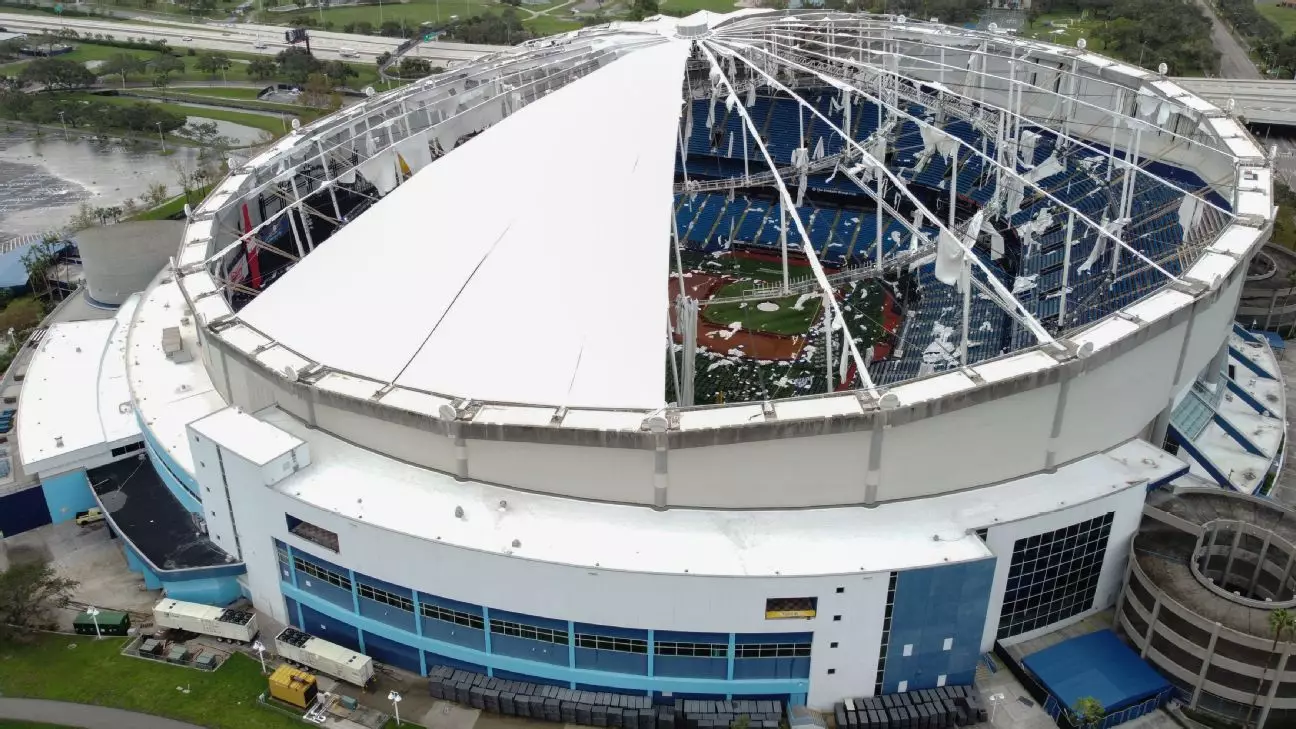In the wake of the devastation caused by Hurricane Milton, the city of St. Petersburg is poised to breathe new life into Tropicana Field, home of the Tampa Bay Rays. A recent city council vote sanctioned $22.5 million for crucial roof repairs, a necessary step towards restoring the stadium’s functionality for the 2026 season. This approval, characterized by a narrow 7-1 margin, underscores the commitment of city officials to fulfill a contractual obligation despite the Rays’ withdrawal from a planned $1.3 billion new stadium deal.
The council has emphasized the importance of this decision, with council member Lissett Hanewicz articulating the legal imperative: “We are legally bound by an agreement.” This statement resonates within the broader narrative of civic responsibility, highlighting that even in the face of unexpected challenges, obligations to the community must prevail. The need to repair Tropicana Field is not merely about brick-and-mortar but about sustaining a cultural and historical touchstone in the Tampa Bay region.
Temporary Home and Fan Engagement
As the repairs get underway, the Rays have adapted by temporarily relocating to Steinbrenner Field, sharing a venue with the New York Yankees. The team has performed moderately well in their new temporary home, securing a 4-2 record during their inaugural series. This shift reflects the resilience of the organization and its fans, who are experiencing a unique yet different atmosphere at an open-air facility designed for spring training rather than regular-season play.
This adjustment illustrates the community’s strong ties to the team, showcasing the passionate fan culture that continues to thrive even amidst uncertainty. While the Trop undergoes renovations, it remains to be seen how this shift will affect fan loyalty. Will supporters continue to rally behind the Rays in their temporary setting, or will frustrations mount over the uncertainty surrounding the stadium’s future?
The Future of Tropicana Field
The ambitious plans to restore Tropicana Field go beyond mere roof repairs. The overall renovation, projected to cost around $56 million, aims to enhance the facility significantly. City architect Raul Quintana outlined a comprehensive overhaul that includes upgrading the playing surface, modernizing audio-visual systems, and revitalizing concession areas. Such upgrades are imperative not just for the Rays but for the community at large, as successful sporting venues are catalysts for economic growth, events, and a sense of pride.
Yet, this developmental strategy raises critical questions about the long-term plans for the Rays. With an existing agreement that requires them to remain at Tropicana Field until at least 2028, there is uncertainty regarding their eventual aspirations. Will the team seek a more permanent relocation to Tampa, or is there still hope for a revitalized relationship with St. Petersburg? Major League Baseball has emphasized the importance of retaining the Rays within the Tampa Bay area, adding another layer of complexity to the situation.
The Complexity of Civic Obligations
The dynamics of governance entwined with sports serve as a microcosm of broader societal issues. City council member Brandi Gabbard’s candid remarks reveal a dual awareness of the financial burdens involved in the stadium repairs while expressing a desire to allocate resources towards hurricane recovery in affected neighborhoods. This sentiment highlights a common tension between public expenditure on sports infrastructure and the pressing needs of the community.
As the council prepares for further discussions regarding the financial aspects of the Tropicana repairs, it’s vital to recognize that such investments aren’t merely about sustaining a baseball team. They reflect a commitment to community cohesion, economic growth, and cultural pride. The Trop is more than just a sports venue; it represents a gathering place, a community hub where memories are forged, from thrilling home runs to unforgettable moments shared among fans.
Weathering the Storms Ahead
The unique membrane roof system set to be installed, with specifications to withstand hurricane winds up to 165 mph, speaks volumes about the city’s forward-thinking strategy. This structural enhancement underscores the need for resilience—not just in terms of infrastructure but also in the spirit of the community itself. The aftermath of Hurricane Milton serves as a reminder that while nature can inflict damage, the human capacity for recovery and adaptation remains strong.
As work commences on the Tropicana Field renovations, the focus must remain on ensuring that the facility not only meets the functional demands of Major League Baseball but also embodies the hopes and dreams of the Tampa Bay community. This process may serve as a powerful narrative of rebirth, showcasing how a region can rally together in the face of adversity, creating a brighter, united future for all involved.


Leave a Reply